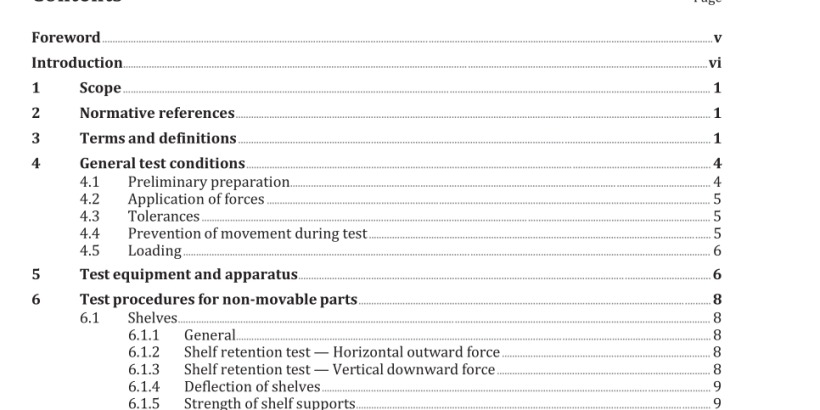ISO 7170:2021 pdf download – Furniture — Storage units — Test methods for the determination of strength, durability and stability.
3.12 extension element component (3.7 ) that can be pulled out and pushed in EXAMPLE Drawers, suspended pocket files, keyboard tray ( 3.25). 3.13 flap horizontally hinged door, which opens upwards or downwards 3.14 free-standing unit unit (3.27 ) not intended to be attached to a load bearing structure 3.15 height adjustment device adjustable device intended to enable height adjustment of a unit (3.27 ), such as a work surface 3.16 interlock device that restrains the opening of more than one extension element (3.12) at a time 3.17 latching mechanism mechanism that retains an extension element (3.12) or a door in the closed position and that requires a second action to release it and can require a key or a combination in order to activate it 3.18 levelling device adjustable device intended to keep an item of furniture horizontal with a limitation of 40 mm of vertical range EXAMPLE Adjustable feet or similar. 3.19 locking mechanism mechanism that limits access to the interior of a unit (3.27 ) or a storage element and that requires a key or a combination in order to activate it or to make it possible to activate it
4 General test conditions 4.1 Preliminary preparation The unit(s)/component(s) shall be tested as delivered. The unit(s)/component(s) shall be assembled and/or configured according to the instructions supplied. Unless otherwise stated, the most adverse configuration (3.8) shall be used for each test. If mounting or assembly instructions are not supplied, the mounting or assembly method shall be recorded in the test report. Fittings shall be tightened before testing and shall not be re-tightened unless specifically required in the manufacturer ’s instructions. If the configuration needs to be changed in order to produce the worst-case (3.26 ) conditions, this shall be recorded in the test report. During testing, the unit shall be placed on the floor and levelled, unless otherwise specified. The levelling device (3.18) shall be set to the mid position but not more than 13 mm from fully closed. A combination of tests can be necessary to cover the properties of multifunction components (e.g. a receding door shall be tested both as a sliding door and as a pivoted door). Unless otherwise specified by the manufacturer, the sample for test shall be stored in indoor ambient conditions for at least 24 h immediately prior to testing. The tests shall be carried out in indoor ambient conditions at a temperature between 15 °C and 27 °C. If during a test the temperature is outside of the range of 15 °C to 27 °C, the maximum and/or minimum temperature shall be recorded in the test report. In addition, the test for deflection of shelves (6.1.4) and sustained load tests (6.2.1) except metal, stone and glass shelves, shall be carried out at a relative humidity of 45 % to 55 %. If during a test the relative humidity is outside this range, the maximum and/or minimum shall be recorded in the test report.
4.2 Application of forces The test forces shall be applied sufficiently slowly to ensure that negligible dynamic force is applied. Unless otherwise specified, each specified force shall be maintained for not less than 10 s and not more than 15 s. The test forces in durability tests shall be applied at a rate to ensure that excessive heating (3.11) does not occur. Unless otherwise specified, each test force shall be maintained for (2 ± 1) s. Forces shall be applied in a manner that ensures normal functioning of self-closing and damping mechanisms. The forces can be replaced by masses. The relationship 10 N = 1 kg shall be used. In Annex B , loads, forces and cycles are suggested to ensure that the test methods are of use where no requirements document is available, or to assist in the development of one. See also Annex A for guidance to develop requirements documents. 4.3 Tolerances Unless otherwise stated, the following tolerances are applicable to the test equipment: — forces: ± 5 % of the nominal force; — velocities: ± 10 % of the nominal velocity; — masses: ± 1 % of the nominal mass; — dimensions: all dimensions less than 200 mm shall have an accuracy of ± 1 mm of the nominal dimension; the other dimensions shall have an accuracy of ± 0,5 %; the dimension of the spherical curvature of 300 mm radius on the loading pad (5.5) shall have an accuracy of ± 5 mm; — angles: ± 2° of the nominal angles. The accuracy for the positioning of loading pads shall be ± 5 mm. Test forces, masses, dimensions, velocities and angles used to perform the test shall be targeted at the nominal values specified and shall be subjected to the above tolerances. NOTE For the purposes of uncertainty measurement, test results are not considered to be adversely affected when the above tolerances are met.
